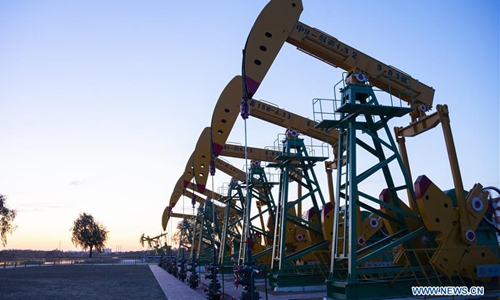HOME >> SOURCE
China's major oilfields maintain pace amid oil crash
By Wang Sheng Source:Globaltimes.cn Published: 2020/3/17 7:20:20

Photo taken on Sept. 27, 2019 shows equipment at Daqing Oilfield in northeast China's Heilongjiang Province. Photo: Xinhua
Crude oil prices dropped below break-even operating expenses for Chinese oil companies, but major oil fields have maintained stable production. Faced with pressure from low oil prices, they have been forced to use low-cost oil production over more expensive methods.
Xinjiang Oilfield, a subsidiary of China National Petroleum Corp (CNPC), with about 10 million tons of crude oil in annual output, has maintained normal operations.
Shengli Oilfield, a subsidiary of China Petroleum & Chemical Corp, is also operating at a normal pace, sources told the Global Times on Monday.
Faced with pressure from low oil prices, national oil companies have emphasized low-cost production methods, Gu Hongjun, a senior engineer at CNPC's Xinjiang Oilfield told the Global Times.
If the oil-price crash persists, small fields whose production costs are higher than break-even costs should maintain low-level operations or will be shut down temporarily to save money, experts told the Global Times.
"Expensive oilfields should not be closed blindly. If they close some high-cost oilfields, oil companies may pay more when restarting production, compared with low-operation methods," Gu said.
Oil companies need to conduct in-depth analysis of their fields and break-even costs. Small fields may be closed temporarily due to lack of facilities and longer production time, experts said.
In addition, unconventional oil may develop slowly due to the oil-price crash. CNPC's Changqing Oilfield has the largest tight oil pilot area in China, and its oil per barrel is higher than current oil prices.
New projects for boosting oil capacity could be postponed, said Cheng Qigui, chief expert from Changqing Oilfield, to the Global Times.
However, the top three oil companies need to maintain output at roughly 200 million tons for energy security. For 2017, China's crude oil output should reach 200 million tons for 2020.
National oil companies will spare no effort to achieve the national target even with the current weak oil prices, Gu said.
"It is still uncertain how long the plunging oil prices will last. Information about whether China adjusts this year's output of high-cost oilfields may be released in the second half of 2020," Gu added.
In fact, to fulfill the target, the top three companies have attached importance to unconventional oil drilling methods in recent years. Experts said the transition from conventional to unconventional oil and gas drilling is an inevitable trend due to mature fields with exploration and production costs.
China produced 32 million tons of crude oil in January and February, up 3.7 percent year-on-year, and imported 86.09 million tons of crude oil, up 5.2 percent year-on-year.
Natural gas output in China during the period hit 31.4 billion cubic meters, up 8 percent year-on-year, and 17.8 million tons of natural gas were imported, up 2.8 percent year-on-year, according to official data released on Monday.
Posted in: INDUSTRIES